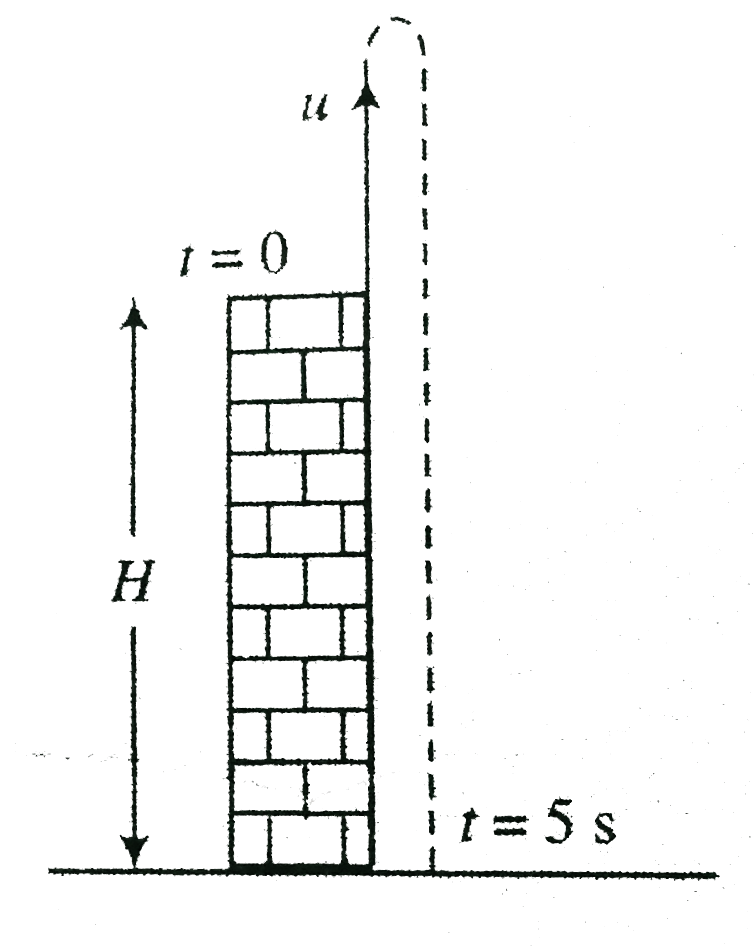A particle is thrown vertically up from the top of a building of height 20m with initial velocity u. A second particle is released from the same point 1 second later. If both particles reach the ground at the same instant ,3u=m/s. [Takeg=10m/s2]
The correct Answer is:B
To solve the problem step by step, we will analyze the motion of both particles and apply the equations of motion.
Step 1: Understand the problem
We have two particles:
- Particle 1 is thrown vertically upwards from the top of a 20 m building with an initial velocity u.
- Particle 2 is released from the same point 1 second later.
Both particles reach the ground at the same time.
Step 2: Define the time of flight for both particles
Let the time taken by Particle 1 to reach the ground be T. Therefore, the time taken by Particle 2 to reach the ground will be T−1 seconds (since it is released 1 second later).
Step 3: Write the equation of motion for Particle 1
Using the equation of motion:
S=ut+12at2
For Particle 1:
- Displacement S=−20 m (downward)
- Initial velocity u
- Acceleration a=−g=−10m/s2 (acting downward)
The equation becomes:
−20=uT−12⋅10⋅T2
This simplifies to:
−20=uT−5T2(1)
Step 4: Write the equation of motion for Particle 2
For Particle 2:
- Displacement S=−20 m (downward)
- Initial velocity = 0 (since it is released)
- Acceleration a=−g=−10m/s2
The equation becomes:
−20=0⋅(T−1)−12⋅10⋅(T−1)2
This simplifies to:
−20=−5(T−1)2
Dividing by -5 gives:
4=(T−1)2
Taking the square root:
T−1=2orT−1=−2
Thus, T=3 seconds (we ignore the negative solution as time cannot be negative).
Step 5: Substitute T back into the equation for Particle 1
Now substituting T=3 seconds into equation (1):
−20=u(3)−5(32)
This simplifies to:
−20=3u−45
Rearranging gives:
3u=45−20
3u=25
Step 6: Solve for u
Now we can find u:
u=253m/s
Final Answer
Thus, the initial velocity u is:
u=253m/s
We have two particles:
- Particle 1 is thrown vertically upwards from the top of a 20 m building with an initial velocity u.
- Particle 2 is released from the same point 1 second later.
Let the time taken by Particle 1 to reach the ground be T. Therefore, the time taken by Particle 2 to reach the ground will be T−1 seconds (since it is released 1 second later).
Using the equation of motion:
S=ut+12at2
For Particle 1:
- Displacement S=−20 m (downward)
- Initial velocity u
- Acceleration a=−g=−10m/s2 (acting downward)
−20=uT−12⋅10⋅T2
This simplifies to:
−20=uT−5T2(1)
For Particle 2:
- Displacement S=−20 m (downward)
- Initial velocity = 0 (since it is released)
- Acceleration a=−g=−10m/s2
−20=0⋅(T−1)−12⋅10⋅(T−1)2
This simplifies to:
−20=−5(T−1)2
Dividing by -5 gives:
4=(T−1)2
Taking the square root:
T−1=2orT−1=−2
Thus, T=3 seconds (we ignore the negative solution as time cannot be negative).
Now substituting T=3 seconds into equation (1):
−20=u(3)−5(32)
This simplifies to:
−20=3u−45
Rearranging gives:
3u=45−20
3u=25
Now we can find u:
u=253m/s
Thus, the initial velocity u is:
u=253m/s
Topper's Solved these Questions
- BOOK - VMC MODULES ENGLISHCHAPTER - KINEMATICS OF A PARTICLE EXERCISE - JEE MAIN (archive)19videos
KINEMATICS OF A PARTICLE
- BOOK - VMC MODULES ENGLISHCHAPTER - KINEMATICS OF A PARTICLE EXERCISE - JEE Advanced (archive)14videos
KINEMATICS OF A PARTICLE
- BOOK - VMC MODULES ENGLISHCHAPTER - KINEMATICS OF A PARTICLE EXERCISE - LEVEL 175videos
KINEMATICS OF A PARTICLE
- BOOK - VMC MODULES ENGLISHCHAPTER - JEE MAIN REVISON TEST-23EXERCISE - PHYSICS (SECTION 2)1videos
JEE MAIN REVISON TEST-23
- BOOK - VMC MODULES ENGLISHCHAPTER - LAWS OF MOTION EXERCISE - IMPECCABLE53videos
LAWS OF MOTION
Similar Questions
A ball is thrown vertically upwards from the top of a building of height 24.5 m with an initial velocity 19.6 ms−1. Taking g = 9.8 ms, calculate : the velocity with which it will strike the ground .
View SolutionA ball is thrown vertically upwards from the top of a building of height 24.5 m with an initial velocity 19.6 ms−1. Taking g = 9.8 ms, calculate : the total time of journey.
View SolutionA particle is fired vertically upwards from the surface of earth and reaches a height 6400 km. Find the initial velocity of the particle if R = 6400 km and g at the surface of earth is 10m/s2.
View SolutionA particle of mass 50 g is projected horizontally from the top of a tower of height 50 m with a velocity 20m/s. If g=10m/s2, then find the :-
View SolutionA stone is dropped from the top of tower. When it has fallen by 5m from the top, another stone is dropped from a point 25m below the top. If both stones reach the ground at the moment, then height of the tower from grounds is : (take g=10m/s2)
View SolutionA particle is dropped from the top of a high building 360 m. The distance travelled by the particle in ninth second is (g=10m/s2)
View SolutionA ball is thrown vertically upward with a velocity u from the top of a tower. If it strikes the ground with velocity 3u, the time taken by the ball to reach the ground is
View SolutionA ball is dropped from the top of a tower of height 78.4 m Another ball is thrown down with a certain velocity 2 sec later. If both the balls reach the ground simultaneously, the velocity of the second ball is
View SolutionA particle is projected up with initial speed u=10ms−1 from the top of a bitlding at time t=0. At time t=5s the particle strikes the fround. Find the height of the building.
 .View Solution
.View SolutionA ball is thrown upward with speed 10 m/s from the top to the tower reaches the ground with a speed 20 m/s. The height of the tower is [Take g=10m/s2]
View Solution

